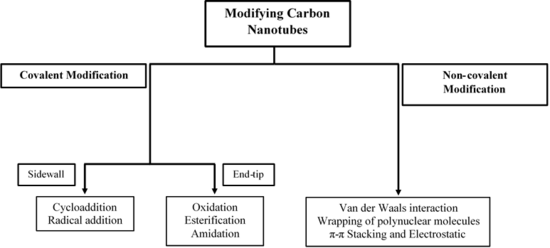Carbon nanotube chemistry involves chemical reactions, which are used to modify the properties of carbon nanotubes (CNTs). CNTs can be functionalized to attain desired properties that can be used in a wide variety of applications.[1][2][3][4][5] The two main methods of CNT functionalization are covalent and non-covalent modifications.[6]
Because of their hydrophobic nature, CNTs tend to agglomerate hindering their dispersion in solvents or viscous polymer melts. The resulting nanotube bundles or aggregates reduce the mechanical performance of the final composite. The surface of CNTs can be modified to reduce the hydrophobicity and improve interfacial adhesion to a bulk polymer through chemical attachment.

| Part of a series of articles on |
| Nanomaterials |
|---|
 |
| Carbon nanotubes |
| Fullerenes |
| Other nanoparticles |
| Nanostructured materials |
- ^ Prato, Maurizio; Kostarelos, Kostas; Bianco, Alberto (2008-01-01). "Functionalized Carbon Nanotubes in Drug Design and Discovery". Accounts of Chemical Research. 41 (1): 60–68. doi:10.1021/ar700089b. ISSN 0001-4842.
- ^ Sun, Ya-Ping; Fu, Kefu; Lin, Yi; Huang, Weijie (2002-12-01). "Functionalized Carbon Nanotubes: Properties and Applications". Accounts of Chemical Research. 35 (12): 1096–1104. doi:10.1021/ar010160v. ISSN 0001-4842.
- ^ Dubey, Rama; Dutta, Dhiraj; Sarkar, Arpan; Chattopadhyay, Pronobesh (2021). "Functionalized carbon nanotubes: synthesis, properties and applications in water purification, drug delivery, and material and biomedical sciences". Nanoscale Advances. 3 (20): 5722–5744. doi:10.1039/D1NA00293G. ISSN 2516-0230. PMC 9419119. PMID 36132675.
- ^ Luo, Shao-Xiong Lennon; Swager, Timothy M. (2023-09-28). "Chemiresistive sensing with functionalized carbon nanotubes". Nature Reviews Methods Primers. 3 (1). doi:10.1038/s43586-023-00255-6. ISSN 2662-8449.
- ^ Xu, Jiang; Cao, Zhen; Zhang, Yilin; Yuan, Zilin; Lou, Zimo; Xu, Xinhua; Wang, Xiangke (March 2018). "A review of functionalized carbon nanotubes and graphene for heavy metal adsorption from water: Preparation, application, and mechanism". Chemosphere. 195: 351–364. doi:10.1016/j.chemosphere.2017.12.061.
- ^ Karousis, Nikolaos; Tagmatarchis, Nikos; Tasis, Dimitrios (2010-06-14). "Current Progress on the Chemical Modification of Carbon Nanotubes". Chemical Reviews. 110 (9): 5366–5397. doi:10.1021/cr100018g. PMID 20545303.